Cool Jobs: New tools to solve crimes
Meet three researchers developing cutting-edge forensic techniques
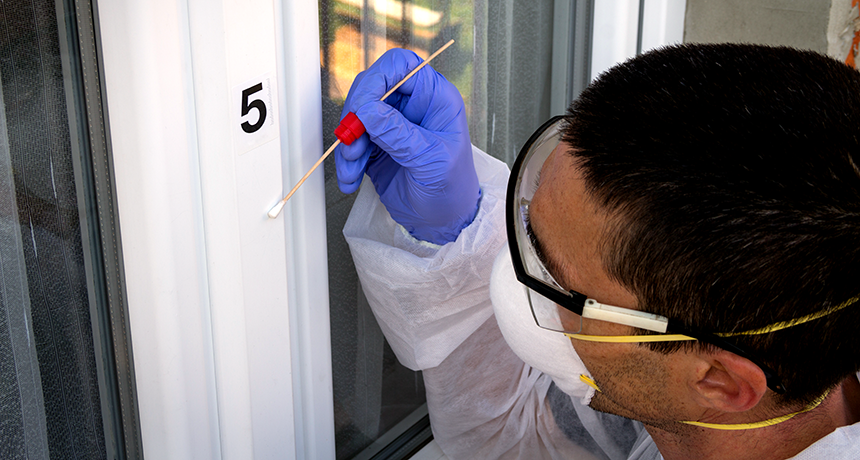
Investigators use forensic science to help solve crimes. Researchers are developing new techniques that could help.
zoka74/iStockphoto
In broad daylight one spring afternoon in Naperville, Ill., two burglars snuck into a suburban home. They took food out of the fridge. They sat on the couch. They picked up framed photos. “We didn’t steal anything,” says Candace Young. She was one of the “burglars.” They were tasked with simulating a crime — all in the name of science, of course.
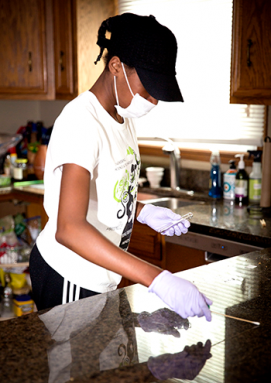
Young is a junior at Chicago State University studying biochemistry. Her accomplice was fellow student Doris Martin, a computer-science major. They pretended to rob the house as part of a research study. Before they entered the home, scientists used cotton swabs to sample the microbes in their noses and hands.
While Young and Martin were inside, the women marked each place they touched with sticky notes. After the mock robbery, researchers sampled Young and Martin’s microbes again. Another team of students donned masks and gloves, then swooped into the home. They swabbed every place the burglars had touched, looking for bacteria and other microbes the women might have left behind.
Jack Gilbert is a microbiologist at the University of Chicago in Illinois. He helped organize the fake break-in. His team also matched samples from the home to samples from Young’s skin. And they caught her, Young says with a laugh. Someday, the research she took part in could help investigators nab real criminals.
Forensic scientists use science to solve crimes. And researchers at labs around the world are developing new techniques to do this. Gilbert’s team, for instance, is investigating how microbial signatures might identify suspects. Another research group is working on a way to identify people from proteins found in a tiny strand of hair. And yet another scientist is studying the microbes that gather on a person’s body after death. The mix of microbes living on a corpse could point precisely to when their host had died.
Forensic research can be tedious and sometimes gruesome. But police and investigators “need more types of evidence,” says Gilbert. To piece together the truth about a crime, they need all the scientific tools they can get.
Of bugs and burglars
One of Gilbert’s first jobs involved studying bacteria in Antarctica. Some of these germs modify the structure of the ice in which they live. He was trying to learn how they do this in hopes of making ice cream smoother.
“My job takes me to many different places,” he says. But now he studies bacteria and other microbes that form communities called microbiomes (MY-kroh-BY-oams). A microbiome can form anywhere. Gilbert is most interested in those that form on people. A person’s nose, hands, gut and many other places can each house their own distinct community of microbes.
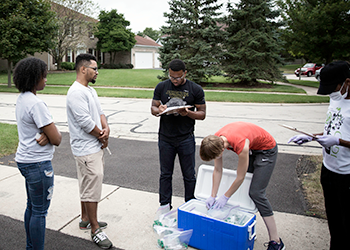
“The bacteria that live in our body appear to be quite unique to us,” Gilbert says. And people shed these bacteria everywhere they go. “Think of Pig-Pen,” he says. That’s the character in the Peanuts cartoon who was always surrounded by dirt. “It’s like this cloud around you.” If you touch a surface, you leave behind millions of bacteria and other microbes. If each person’s community of microbes is unique, this bacterial smudge could act like a fingerprint.
In the fake robbery, Gilbert and his colleagues tried to capture such “fingerprints.” Collecting microbial samples from a crime scene, or from a suspect, is surprisingly simple. Student investigators just run cotton swabs over a surface. Then they seal each swab inside a sterile container. Each sample tends to hold hundreds of thousands — or even millions — of single-celled organisms. And each microbe has its own DNA.
Back at the lab, Gilbert’s team extracts DNA from microbes in the sample. They use machines to look at the DNA’s code. The results tell them what mixture of species was present. This mix will vary from person to person.
Extracting DNA from the sample is cheaper and easier than trying to identify microbes visually under a microscope, Gilbert explains. “Microbes are very, very, very small,” he says. “Species of bacteria that are as different as an antelope from an octopus can look identical under a microscope.” But their DNA, he notes, tells the story of who they are and what they do.
His group has staged dozens of burglaries — so far, in Illinois, New York and Florida. They are trying to prove that they can find burglars’ microbial fingerprints under different conditions. These include different types of homes and different seasons. The scientists are also asking people from various backgrounds to pose as burglars.
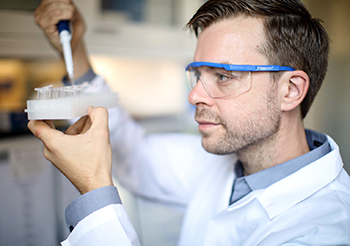
Their research is not yet complete. It will take another year or more to understand this, says Gilbert. And even once the team publishes results from its study, the science will have a long way to go. “It will be many, many years before [microbial fingerprinting] is used in actual forensic activity,” Gilbert suspects.
Jonathan Eisen, who is not involved in the burglary research, agrees. He is a microbiologist at the University of California in Davis. “I think this technique has the potential to be incredibly powerful,” he says. But he’d like to see the work published. And he cautions that it’s much too early to use microbial fingerprinting to solve real crimes.
One issue is that the science of analyzing microbial DNA is still imprecise. Imagine giving the same set of microbe samples to four groups of researchers, Eisen says. You’d think that each group would find similar populations of germs. But that’s not what happens. Their results can vary a lot, depending on who does the analysis. He says, “You should be very skeptical of using [such a technique] in an investigation where someone’s life and safety and future freedom is at stake.”
Splitting hairs
DNA evidence from humans is still the best way to link a suspect to a crime. The process for analyzing this evidence is consistent and reliable. Plus, experts can check the evidence against huge databases of people’s DNA. If their DNA shows up at the crime scene, a suspect was probably there. But investigators don’t find DNA evidence at every crime scene. DNA just doesn’t stick around that long. The fragile genetic strands can break down easily.
Hair, however, is stronger stuff. Its proteins often last hundreds of years.
And these offer a new way to identify people. “It’s indirect DNA evidence,” notes Deon Anex. He’s a chemist at Lawrence Livermore National Laboratory in California. Anex is looking for ways to match hair proteins to people.
DNA contains the instructions for building proteins. Cells follow those instructions to make building blocks called amino acids. Those amino acids combine to form proteins. A small difference in the DNA, called a mutation, can change a protein’s amino-acid makeup.
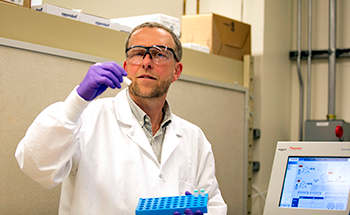
Anex’s team is tracking down these changes in hair proteins. Each out-of-place amino acid they find means there’s a mutation in the DNA. If the team can find enough of these markers, they can use them to identify the person the hair came from. Or they could say that a hair definitely didn’t come from a particular person.
To begin this research, Anex’s team needs 50 to 100 hairs from each volunteer. “People were nervous about how much hair they were giving,” he says. Then someone suggested that they hire a stylist and offer a free haircut. That made hair donations much easier to get, Anex says.
To discover new markers, the team must literally split hairs. First, they grind up the strands of hair into a paste. Next, they add enzymes — hardworking substances similar to the ones that break down food in the stomach. These enzymes chow down on the hair proteins, breaking them into smaller pieces called peptides. Finally, Anex’s team feeds these peptides into a machine that breaks them into even smaller fragments. These fragments reveal the order of amino acids in each peptide.
Anex knows how amino acids line up in a normal hair protein. When he finds an amino acid that’s out of place, it could be a new marker. His team has collected about 50 markers so far. But they’ll need at least 100 to match a hair to its owner with confidence.
And there’s another problem: Criminals don’t often leave handfuls of their hair behind. So Anex’s team is working on ways to analyze the proteins in a single, one-inch strand of hair. They’re also comparing head hair to hairs from other parts of the body. In a few years, Anex says, the technique should be ready to use in real cases. Teeth, bones and skin cells also contain protein, he adds. Future research could target these types of protein as well.
Life after death
Identifying suspects is a major part of forensic science. But science can help solve crimes in other ways, too. In a murder case, one of the most important facts to pin down is the time of death. A suspect who can prove that he or she was somewhere else at the time of the murder clearly couldn’t have killed the victim.
Medical examiners currently have several ways to estimate time of death. After death, a body goes through predictable changes. Its temperature slowly drops, for instance. And the muscles stiffen in a process called rigor mortis. Small muscles stiffen first. Larger muscles follow. Where a body is in this series of changes can lead to an estimate of when death happened.
But these methods only work if investigators find the dead body within a few days. To help with bodies that aren’t discovered for weeks or more, Jessica Metcalf is developing a new method. She’s a microbial ecologist at Colorado State University in Fort Collins. Metcalf studies the communities of bacteria, fungi and tiny worms that colonize a corpse. “When a person or any mammal decomposes, waves of microbes are part of that process,” she explains. “Different sets of microbes become abundant at different times.”
Metcalf is creating a timeline of decomposers. The timeline starts at death, then tracks each wave of microbes that live on a corpse over the next several weeks. Eventually, investigators might be able to take a sample of microbes from a body and check it against the timeline. This could reveal how long the body has been decomposing.
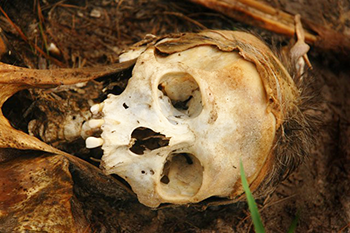
To create this timeline, Metcalf’s team has to start with real human bodies. Some people offer to donate their bodies after they die for use in forensic research. Working with donor bodies is “a unique and touching experience,” Metcalf says.
In a recent study, her team placed four bodies on the ground outside, unprotected, at the Southeast Texas Applied Forensic Science Facility. This facility is part of Sam Houston State University in Huntsville. They set out two of the bodies in the winter and two in the spring. They returned regularly over the next several months to take samples.
Collecting microbe samples from a decaying body is a tough job. Metcalf visits the bodies sometimes, but students are usually the ones who do it. They wear a full suit of protective gear, including masks, gloves and coveralls. Unfortunately, there’s really no way around the disturbing sights and smells, Metcalf notes.
Placing bodies outside in different seasons has helped her team learn how temperature affects the microbial timeline. Heat speeds up the clock. Cold slows it down. Many other factors also might affect the timeline. These might include the type of soil, rainfall, humidity, insects and whether the body is inside or out.
Controlling all these factors is nearly impossible outdoors. So Metcalf’s team ran an experiment with mice. They placed 120 dead mice on top of three types of soil. Then they sampled the bodies over the course of 10 weeks. Metcalf was surprised to find that soil type was not important. The microbial timeline was the same on each soil. And over the first two weeks of the experiment, her team could use microbes to predict a mouse’s time of death to within two or three days.
When the researchers compared the timelines for mice and humans, the waves of microbes matched closely. However, there’s more work to be done before the timeline is ready for the courtroom.
Metcalf is now running a study with 36 human bodies. Her team placed them outdoors in three parts of the United States throughout the four seasons. Another experiment, with researchers at Sam Houston State University, will watch how bodies decompose in sheds. Both experiments will test the accuracy of Metcalf’s timeline. If everything goes well, Metcalf predicts that crime scene investigators may be using her method within five years.
The more tools that forensic investigators have available to them, the more they can learn about a crime. Each bit of evidence is like a single puzzle piece that fits into the larger picture of what actually happened.
“We wouldn’t go into a house and just use bacteria to try to identify someone,” Gilbert says. Bacteria and other microbes would be just one of many sources of information. Proteins in hair, teeth, bones or skin cells could add to the picture. So could future techniques that haven’t been invented yet. These tools will help investigators tell the difference between the guilty and innocent — and, of course, fake burglars.
This is one in a series on careers in science, technology, engineering and mathematics made possible with generous support from Arconic Foundation.







